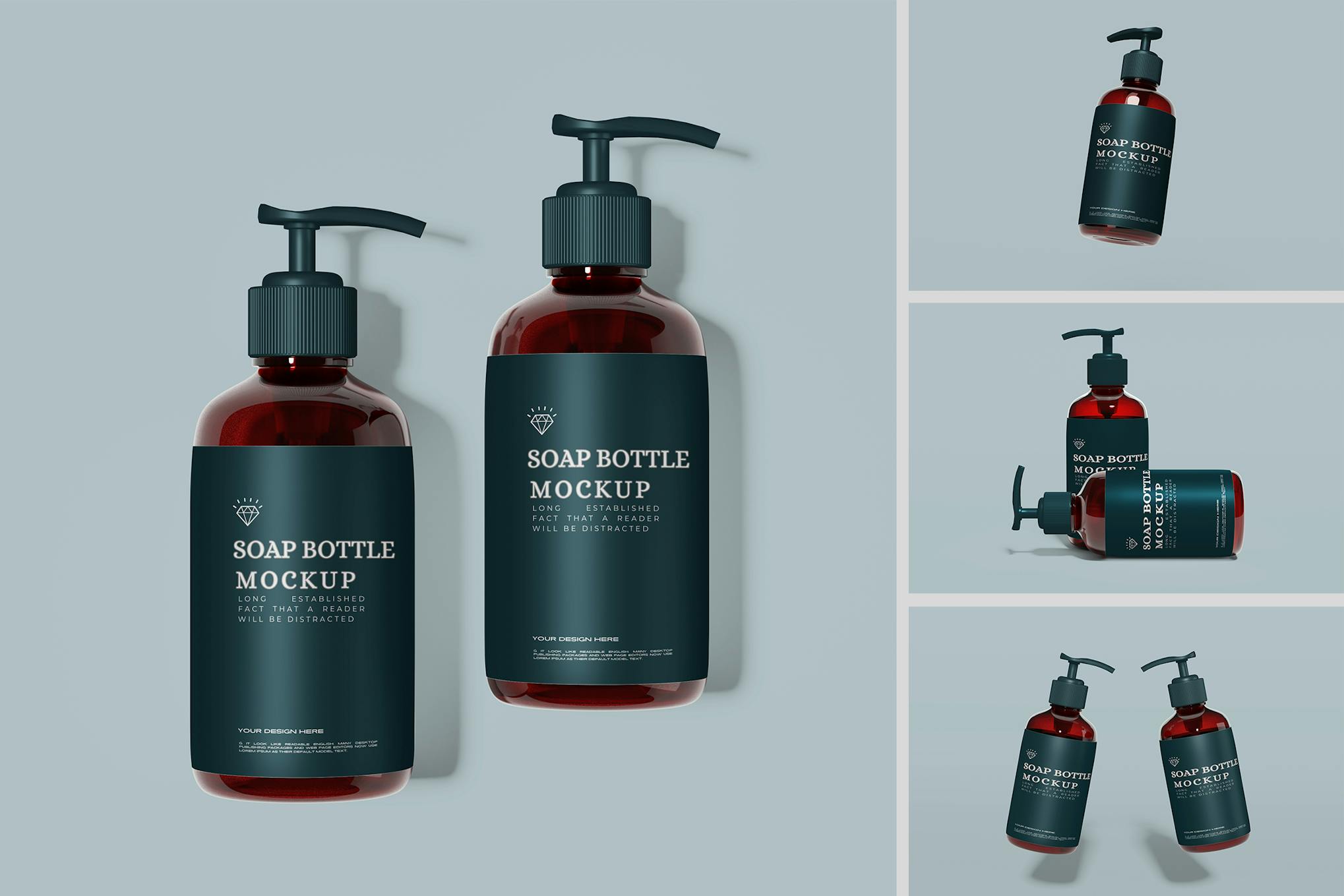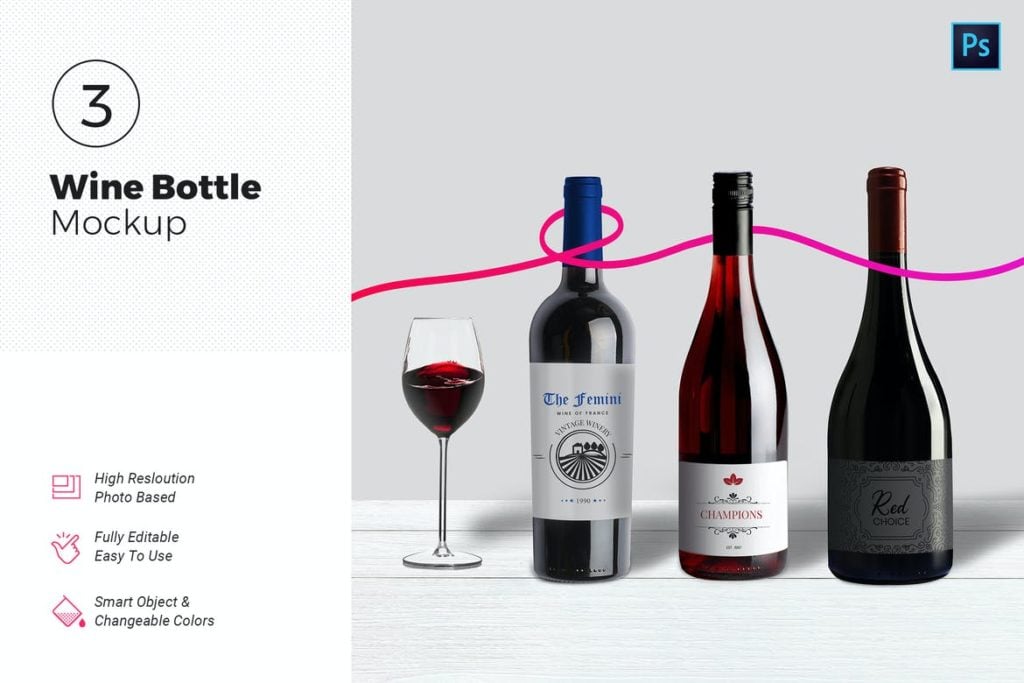40+ Bottle Mockup Templates (Free & Pro)
Bottles are one of the most versatile packaging items on the planet, and not only can the right bottle design make your product stand out on the shelf, but it’ll also act as an incentive for the consumer to purchase it.
Whether you’re designing a range of bottles for a line of products, or wanting to promote your company by selling bottles with your logo on them, there are tonnes of ways to customize them – but it’s important to make sure that the design looks perfect before you commit to printing or manufacturing them in bulk.
We’ve curated a list of the best free and premium bottle mockup templates for you to download and customize with your bottle design, to bring your creation to life instantly. Read on, and pick your favorite!
Design Your Own Bottle Mockup in Seconds
Why settle for one bottle mockup template when you have access to thousands of different kinds of glass or plastic bottle mockups for just one price? Plus, you can edit all these templates online, without ever needing to use Photoshop.
That’s exactly what Placeit does. It lets you use high-quality mockups, edit them using its online editor, place your own designs, and download them quite easily. No need for Photoshop. And yes, it includes loads of bottle mockups too, for different types of bottles, in all sorts of settings. Think of it as a bottle mockup generator. But of course, it’s more than that.
Modern Bottle Mockup Scene
The bold and beautiful presentation of this mockup makes it one of the best templates on our list. It has a cool and creative scene surrounded by nature, which will add a natural vibe to your design presentations. This mockup comes in a high-resolution PSD file.
Luxury Perfume Bottle Mockup Template
Showcasing your luxury perfume label, branding, and packaging design will be much easier when you have an amazing mockup like this one. It features an elegant mockup scene with a unique background. It will definitely win over your clients.
Skincare Dropper Bottle Mockup
With this mockup, you can showcase your branding and label designs for various types of skincare products. It features a dropper bottle mockup with a creative background scene with a 3D-like design.
Juice Bottle Mockup Templates
This is a collection of beautiful bottle mockups for showcasing designs related to juice brands. It includes 4 different mockups with creative bottle arrangements and layouts. You can easily customize each mockup using Photoshop to change the background too.
Free Mini Spray Bottle Mockup
You can download this bottle mockup for free to showcase your designs using a stylish scene. It features a small spray bottle with a label mockup. It can be easily customized using smart objects.
Juice Plastic Bottles Mockup
This is a collection of isolated, high-resolution juice bottle mockup set offering stunning clarity with a size of 4500 x 3129 px. Smart Objects make it easily editable, while its organized layers and editable colors provide maximum customization.
Cosmetic Bottle Mockup Template
A high-quality cosmetic bottle mockup for beauty brands looking for an outstanding display of their products. This PSD file, meticulously crafted for water, beverages, or tumbler packaging portrayals, features smart object integration, high resolution, and a well-organized layer system.
Juice Bottles Mockup Templates
A fully customizable mockup set perfect for showcasing your juice bottle and label designs. With its 3500 x 3500 px size, named and organized layers, and editable colors using smart objects, the mockups provide an excellent way to present your designs.
Water Bottles Mockup Set
A set of water bottle mockups for showcasing your designs like a pro. These high-resolution (3596 x 2500 px) templates feature isolated mockups that are fully editable with Smart Objects. It includes organized and labeled layers, editable colors, and a layered PSD file at 300 PPI.
Tumbler Plastic Bottle Mockup
An easily editable mockup set for showcasing your tumbler designs. This set includes six mockups featuring different angles and backgrounds of a tumbler, container, and bottle. It offers high-resolution realistic images with changeable backgrounds, organized layers, and smart object operation.
Thermos Flask PSD Mockup
A customizable, high-quality mockup kit designed to illustrate your thermal flask design ideas in a realistic and visually compelling way. Ideal for showcasing beverage containers like tumblers, sports bottles, or thermoses, it can also be used for cosmetics or merchandising presentations.
Supplement Bottle Mockup
This Photoshop mockup template includes three scenes with organized PSD files and well-structured layers. Conveniently customizable, it utilizes smart-object functionality for showcasing your medical, cosmetic, and supplement bottle designs.
Pill Vial Bottle Mockup Template
A realistic vial bottle mockup, perfect for enhancing your medical pill bottle design presentations. Its high-resolution PSD file (3000 x 2000px, 300 DPI) features organized layers and folders for ease of editing. With a changeable background color and an easy-to-use smart object layer, modifying this mockup to suit your needs is a breeze.
Soap Dispenser Bottle Mockup
This is a beautifully designed mockup, ideal for showcasing your unique soap bottle designs. It comprises 4 well-organized, high-quality PSD files, featuring customizable backgrounds and adjustable lighting, ensuring a good look for both bright and dark designs.
Cosmetic Dropper Bottle Mockup
This is a high-resolution mockup designed for showcasing your cosmetic dropper bottle designs. Offering a 6000 x 4000-pixel resolution at 300 dpi, this well-layered and organized mockup is based on professional photos and allows for customization of color and text.
Elegant Perfume Bottle Mockups
This bottle mockup is ideal for presenting branding designs and logo designs for high-end perfume and beauty brands. The mockup features a beautiful mockup scene with a perfume bottle. You can even change the background color to your preference.
Multipurpose Cosmetic Bottle Mockup Templates
A collection of two bottle mockups for cosmetic brands. This pack includes two different styles of multipurpose bottle designs that can be used to showcase perfume sprays, cream bottles, and various other beauty products.
Dropper Bottle Mockup Set
This bundle comes with 6 different mockups in PSD formats. They all feature dropper bottle designs for showcasing your label and product designs related to beauty brands. The templates have editable backgrounds and smart objects as well.
Yogurt Bottle and Box Mockups
You can use this mockup template to promote yogurt brands in a professional way. It includes both bottle and box packaging mockups in one place. There are 6 different mockups for you to choose from in this bundle.
Free Wine Bottle with Label Mockup
This free bottle mockup features a beautiful scene with a full wine bottle. It has an easy-to-edit bottle label that you can easily replace with your own design. The template comes with organized layers and smart objects.
Red Wine Bottle Mockup Template
The first bottle mockup template in our collection is this classic arrangement of a red wine bottle on a rustic wooden table, next to a glass of wine and a bunch of grapes to match. Naturally, this is the perfect bottle mockup for you if you’re designing a wine label, or even for a wine-themed project!
Glass Water Bottle Mockup Template
Continuing the water bottle trend, here we have a zesty little mockup featuring two glass water bottles amongst an array of tropical fruits, making it the perfect mockup for a fruit-infused beverage or even a simple spring water! You can also customize the color of each bottle cap, as well as the bottle itself.
Small Dropper Bottle Mockup Template
If you’re searching for a bottle mockup template that features a smaller, dropper style bottle such as those used for essential oils or health and beauty products, this photorealistic option features a brunette woman holding up a dark glass dropper bottle with your label on it, giving you a great idea of how your product will look.
Aluminum Bottle Mockup Template
Next up is this minimal and modern mockup featuring an aluminum water bottle or flask resting against some rugged brown rocks, with a plain background to create an effective, natural look. The color of the bottle can be customized, but we also think the original silver is pretty eye-catching.
Cosmetic Bottle Mockup Template
Another health and beauty-themed bottle mockup template, this next premium option from Placeit feature three unique cosmetic bottles sitting on top of a marbled stone surface against a faded, natural background. It’s perfect for hand creams, beauty serums, hair products – basically any kind of liquid cosmetic.
Water Bottle Mockup Template
Water bottles are a popular item to feature corporate branding as part of employee swag or promotional products, and this is one of the most popular bottle mockup templates for this purpose. It features three fully customizable bottles with smart object layers and an interchangeable background for easy editing.
Plastic Bottle Mockup Template
Next in our lineup is this free plastic bottle mockup template, featuring a multipurpose bottle on a light wooden surface next to a potted succulent. The example used is a baby oil product, but this highly versatile template can be used for just about any kind of item that would come in a white plastic bottle.
Wine Bottle Mockup Template
Another option for the wine lovers, here is a collection of three different wine bottle mockups, each featuring a high resolution, photo-based image with smart objects and customizable colors, perfect if you want to see your labels on a variety of wine bottle styles.
Swing Top Bottle Mockup Template
Here we have a classic brown glass swing-top bottle that’s typically used to house food and beverage products, such as sauce or craft beer. This free mockup template comes with a high-quality PSD file that includes smart layers for you to customize.
Whiskey Bottle Mockup Template
Our next option, a minimalistic premium design from Envato Elements, is perfect for displaying whiskey labels, but can also work for other kinds of liquor. The background texture and color can be customized, and the smart object layered PSD file makes for quick and easy editing.
Blonde Beer Bottle Mockup Template
This photorealistic bottle mockup template features a blonde beer bottle next to a delicious looking glass, and is ideal if you’re searching for a mockup to showcase your beer bottle label design. It consists of a smart object enabled PSD file that’s available for free download.
Box & Dropper Bottle Mockup Template
Here, we have a bottle mockup template that includes a classic amber dropper bottle as well as an accompanying box, perfect if you’re designing both a bottle label and packaging. It comes with 11 unique and high-quality layouts, each of which is fully customizable using Photoshop.
Coffee Bottle Mockup Template
Next in our collection of bottle mockup templates is this coffee themed design that will be a great option to showcase an iced coffee label, or packaging for a coffee themed product such as body lotion. This free download includes six different layouts, each with smart layers and a high definition resolution.
Pill Bottle Mockup Template
Designing a label for pills or nutritional supplements? This classic pill bottle mockup template from Envato Elements is the perfect way to see your design in real life, and features drag and drop smart objects, interchangeable backgrounds, realistic shadow and shading effects, and well-organized layers.
Sports Bottle Mockup Template
Sports water bottles are a great way to show off your company branding, and this sports bottle mockup template will display your branded sports bottle design in a high-resolution PSD format featuring smart objects, layers and easily customizable color settings.
Dispenser Bottle Mockup Template
The next bottle mockup template in our list is this stunning premium offering from Envato Elements, which depicts a multipurpose pump dispenser bottle on top of a wooden surface with a blurred background, bringing all of the attention to your design.
Prosecco Bottle Mockup Template
This beautiful bubbly themed mockup template is something to celebrate! Why not choose this option to display your bottle label on a classic champagne-style wine bottle, amongst an array of fruit, nuts and herbs, all on top of a grey wooden surface?
Square Juice Bottle Mockup Template
The bottles featured in this bottle mockup template offer a unique squared shape, allowing you to display your rectangular label flat on the side of each bottle lying atop a plush white blanket. This free template includes smart objects for easy editing.
Fruit Juice Bottle Mockup Template
Here we have another juice bottle mockup template, displaying a vintage style glass beverage bottle on top of a plain white table, against a background of marble and green branches. There are four layouts to choose from, all of which can be fully customized.
Spray Bottle Mockup
Our last mockup is of an instant spray bottle. This mockup template can be edited almost instantly using the PSD file’s smart layer to insert your design. Just drag and drop your creative work to get the design you want.
And that concludes our round-up of fantastic bottle mockup templates from both free and premium sources, all available for download right now! Whether you’re designing a label for a drink or beverage bottle, or coming out with your own range of cosmetics, there’s a mockup for every kind of bottle at your fingertips.








































